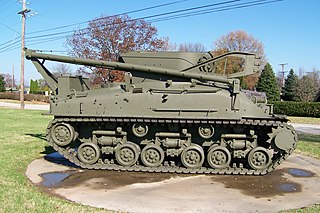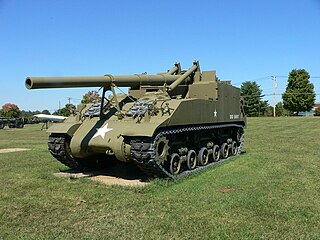 W
WThe 75 mm gun was the standard American gun mounted to a mobile platform during World War II. They were primarily mounted on tanks, but were also mounted on the B-25 Mitchell medium bomber aircraft. There were five variants used during the war: M2, M3, M4, M5, and M6.
 W
WThe Chrysler A57 Multibank is a 30-cylinder 1,253 cu in (20.5 L) engine that was created in 1941 as America entered World War II. It was born out of the necessity for a rear-mounted tank engine to be developed and produced in the shortest time possible for use in the M3A4 Lee medium tank and its successor M4A4 Sherman medium tank. Each had lengthened hulls to accommodate the A57.
 W
WDD or Duplex Drive tanks, nicknamed "Donald Duck tanks", were a type of amphibious swimming tank developed by the British during the Second World War. The phrase is mostly used for the Duplex Drive variant of the M4 Sherman medium tank, that was used by the Western Allies during and after the Normandy Landings in June 1944.
 W
WThe Sherman Firefly was a tank used by the United Kingdom and some Commonwealth and Allied armoured formations in the Second World War. It was based on the US M4 Sherman, but was fitted with the more powerful 3-inch (76.2 mm) calibre British 17-pounder anti-tank gun as its main weapon. Originally conceived as a stopgap until future British tank designs came into service, the Sherman Firefly became the most common vehicle mounting the 17-pounder in the war.
 W
W W
WThe Grizzly I was a Canadian built M4A1 Sherman tank with some relatively minor modifications, primarily to stowage and pioneer tool location and adding accommodations for a number 19 radio set. They used the same General Steel hull castings as late Pressed Steel M4A1(75)s, to include both, the standard hull and the later ones with the armor thickened over the ammo bins. Grizzlies were originally built with US style tracks and sprockets. It was only later that they were refitted with Canadian Dry Pin tracks (CDP) tracks, which did not require rubber.
 W
WThe vertical volute spring suspension system is a type of vehicle suspension system. This type of the suspension system was mainly fitted on US and Italian tanks and armored fighting vehicles starting from throughout the 1930s up until after the end of the Second World War in 1945.
 W
WThe M4 Sherman, officially Medium Tank, M4, was the most widely used medium tank by the United States and Western Allies in World War II. The M4 Sherman proved to be reliable, relatively cheap to produce, and available in great numbers. It was also the basis of several successful tank destroyers, such as the M10, 17pdr SP Achilles and M36B1. Tens of thousands were distributed through the Lend-Lease program to the British Commonwealth and Soviet Union. The tank was named by the British for the American Civil War general William Tecumseh Sherman.
 W
WThe M10 tank destroyer was an American tank destroyer of World War II. After US entry into World War II and the formation of the Tank Destroyer Force, a suitable vehicle was needed to equip the new battalions. By November 1941, the Army requested a vehicle with a gun in a fully rotating turret after other interim models were criticized for being too poorly designed. The prototype of the M10 was conceived in early 1942 and delivered in April that year. After appropriate changes to the hull and turret were made, the modified version was selected for production in June 1942 as the 3-inch Gun Motor Carriage M10. It mounted a 3-inch gun M7 in a rotating turret on a modified M4A2 tank chassis. An alternate model, the M10A1, which used the chassis of an M4A3 tank, was also produced. Production of the two models ran from September 1942 to December 1943 and October 1942 to November 1943, respectively.
 W
WThe M32 Armored Recovery Vehicle was an armored recovery vehicle (ARV) used during World War II and the Korean War by the United States, and was based on the chassis of the M4 Sherman. During World War II, the British also used several hundred M32s, which were obtained through Lend-Lease in 1944. The first four prototypes were produced in January 1943, labeled T5, T5E1, T5E2, T5E3, and T5E4. After a series of tests at the Aberdeen Proving Grounds, the prototypes were approved as M32, M32E1, M32E2, M32E3, and M32E4. However, the M32E4 never entered production. There were also variants that had Horizontal Volute Spring Suspension (HVSS), which were demarcated by an A1 after the model.
 W
WThe M36 tank destroyer, formally 90 mm Gun Motor Carriage, M36, was an American tank destroyer used during World War II. The M36 combined the hull of the M10 tank destroyer, which used the M4 Sherman's reliable chassis and drivetrain combined with sloped armor, and a massive new turret mounting the 90 mm gun M3. Conceived in 1943, the M36 first served in combat in Europe in October 1944, where it partially replaced the M10 tank destroyer. It also saw use in the Korean War, where it was able to defeat any of the Soviet tanks used in that conflict. Some were supplied to South Korea as part of the Military Assistance Program and served for years, as did re-engined examples found in Yugoslavia, which operated into the 1990s. Two remained in service with the Republic of China Army at least until 2001.
 W
WThe 155 mm Gun Motor Carriage M40 was an American self-propelled artillery vehicle built on a widened and lengthened Medium Tank M4A3 chassis, but with a Continental engine and with HVSS, which was introduced at the end of the Second World War.
 W
WThe Sherman M-50 and the Sherman M-51, both often referred to abroad as the Super Sherman, were modified versions of the American M4 Sherman tank that served with the Israel Defense Forces from the mid-1950s to early 1980s. The M-51 was also referred to as the Isherman. However, the designations "Super Sherman" and "Isherman" were never used by the Israeli Defense Forces.
 W
WThe M74 tank recovery vehicle (M74) was an engineer vehicle used by the U.S. Army in the 1950s. It was designed to cope with the heavier weights of the M26 Pershing and M47 Patton. It could also be suitable for light dozing, since it had a hydraulic, front-mounted spade. More than 1000 were produced by Bowen-McLaughlin-York by converting M4A3 Sherman tanks starting in 1954. Later, some were converted from M32B1 ARVs by Rock Island Arsenal until 1958.
 W
WThis article deals with Sherman tanks extensive use around the world after World War II and catalogues foreign post–World War II use and conversions of Sherman tanks and variants based on the Sherman chassis.
 W
WThe 25pdr SP, tracked, Sexton was a Canadian-designed self-propelled artillery vehicle of the Second World War. It was based on Canadian-built derivatives of the American M3 Lee and M4 Sherman tank chassis. Canada had setup to produce the Ram tank using the M3 chassis and Grizzly to complement US medium tank production; when Sherman production in the US expanded and supply was no longer a problem, it was decided in 1943 to switch the Canadian production lines to produce the Sexton to give the British Army a mobile artillery gun using their 87.6 mm (3.45 in) Ordnance QF 25 pounder gun-howitzer for commonality with towed guns. The Sexton could fire either HE shell or an armour-piercing shell. It found use in the Canadian and British Army, as well as numerous other British Empire and associated forces. Just after the war, a number of Grizzly and Sextons were sold to Portugal, who used them into the 1980s.
 W
WThe United States provided tens of thousands of its Medium Tank M4, also named the Sherman, to many of its Allies during the Second World War, under the terms of Lend-Lease.
 W
WThe Sherman M-50 and the Sherman M-51, both often referred to abroad as the Super Sherman, were modified versions of the American M4 Sherman tank that served with the Israel Defense Forces from the mid-1950s to early 1980s. The M-51 was also referred to as the Isherman. However, the designations "Super Sherman" and "Isherman" were never used by the Israeli Defense Forces.
 W
WThe Rocket Launcher T34 (Calliope) was a tank-mounted multiple rocket launcher used by the United States Army during World War II. The launcher was placed atop the M4 Sherman, with its prominent vertical side frames anchored to the turret's sides, and fired a barrage of 4.5 in (114 mm) M8 rockets from 60 launch tubes. It was developed in 1943; small numbers were produced and were used by various US armor units in 1944–45. It adopts its name from the musical instrument "Calliope", also known as the steam organ, which had similar parallel or clustered pipes.
 W
WThe Rocket Launcher T40/M17 (Whizbang) was a tank-mounted multiple rocket launcher used by the United States Army during World War II. The launcher was placed atop the Medium Tank M4, and fired a barrage of 7.2 in (180 mm) T37 HE or T21 Chemical rockets from 20 launch tubes. It was developed and used in the late stages of World War II; it saw limited combat in 1944–45. An experimental short variant of the T40 was also developed.
 W
WThe M4 Sherman tank was produced in several variants, a result of mass production spread across several manufacturers and several years. It was also the basis for a number of related vehicles, and Shermans have been modified by several nations, ranging from upgrades to complete hull conversions for another task. Originally designed in 1941, M4 variants were still used by Israel during the 1967 and 1973 wars.
 W
WThe vertical volute spring suspension system is a type of vehicle suspension system. This type of the suspension system was mainly fitted on US and Italian tanks and armored fighting vehicles starting from throughout the 1930s up until after the end of the Second World War in 1945.
 W
WThe Wright R-975 Whirlwind was a series of nine-cylinder air-cooled radial aircraft engines built by the Wright Aeronautical division of Curtiss-Wright. These engines had a displacement of about 975 cu in (15.98 L) and power ratings of 300–450 hp (220–340 kW). They were the largest members of the Wright Whirlwind engine family to be produced commercially, and they were also the most numerous.